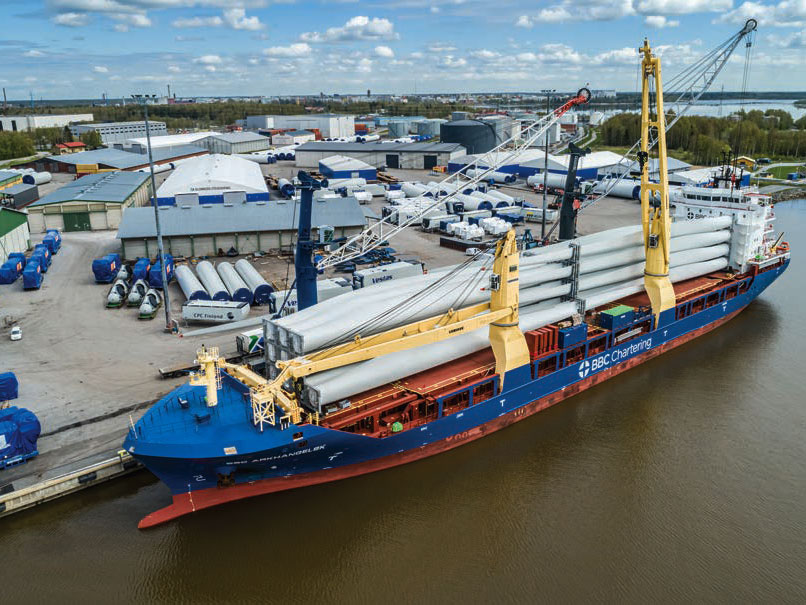At present we find the current state of the MPV/HL [Multi-Purpose Vessel/Heavy Lift] sector, the work-horse ships of the project business, to be in fairly good shape. We have seen a slight pullback in container demand for MPV tonnage, but it has not yet reflected dramatically in respect to time charter rates. Since August of 2020 MPV time charter rates have more than tripled. So, the current flattening of the time charter rates should not come as any surprise after the huge runup we have seen the last few years. The last time I wrote on this subject was May of this year and I noted that COVID-19, the supply chain, and inflation were all flashing red as we moved into the summer. It seems that two out of the three have at least shown signs of improvement while inflation has not. We are starting to see the first signs of how high energy prices impact our everyday life. Earlier in the supply chain crisis, shippers were screaming about the dramatic rise in freight rates but the market has had no choice but to accept and pass along these increases to the end user.
After collapsing in the second half of 2020, global demand for goods skyrocketed past pre-pandemic levels. The change in consumer spending habits, collapse in service sector spending and aggressive government stimulus resulted in a whipsaw effect on the supply chain. The only real solution to improving the supply chain is getting supply and demand back into balance which will take time.
IMO Regulations & Fleet Renewals
In 2020 international shipping went through a significant change when the IMO introduced the Sulphur content cap for marine fuels. The allowable Sulphur content went from 3.5% to 0.5% unless the vessel was equipped with scrubbers. These changes in regulations were over 10 years in the making and allowed owners ample time to prepare. The resulting increase in fuel expenditures and other associated costs in most case was passed along to shippers in the form of higher freight rates.
As we approach 2023 the IMO will again flex its muscles and introduce a number of new regulations and milestones in order to further reduce vessel emissions and reduce carbon intensity for all ships by 2030. These regulations will have the most impact on older vessels resulting in an acceleration of investment in new and more environmentally friendly vessels. The maritime industry is not only feeling heat from the IMO and world governments but is now hearing from companies with their own green initiatives and standards for the future.
There is no reason to think that such policies will not become even more stringent as time moves forward. This has placed many owners in a prickly position on future fleet renewal programs. In other words, if you decide to build a conventional MPV today is there a risk that it could be in non-compliance by the time it is delivered or early in the service life of the vessel? Given the current environment within the sector it is predictable that operating expenses will continue to rise resulting in higher freight rates being passed down throughout the supply chain.

Shipbuilding Impacts on MPVs
Most commercial shipyards are experiencing very high order volume from the container and bulk owners, which further delays the construction and delivery of new MPV’s to the market. High inflation, increased labor and materials costs and higher interest rates are all contributing to the cost of newbuilds. Since 2015 the average cost of the workhorse MPV 12.000 dwt with 500 m/t gear has risen from $19 million to over $31 million. Much like what the auto industry has experienced, the second hand or used vessel market have seen prices skyrocket having more than double in the last 8 years.
The global HL fleet is not expected to see any significant newbuilds with the exception of replacement tonnage for vessels heading to the scrapyard or secondary markets. Making new investments in the MPV fleet is no longer just about financing. The challenge is finding slots at shipyards willing to build a MPV vessel over container and bulk vessels. There are currently just no good options to reverse this current trend. Shippers can expect to see continued capacity shortages in the MPV sector. While freight volumes are forecast to remain strong due to the global energy transition that is underway.
On the U.S. maritime labor front, it appears that we will experience no labor disruptions on the West Coast as the ILWU and PMA have jointly stated that while the current labor agreement has expired that no strike or labor slowdowns will take place as negotiations get closer to the finish line. The current ILA contract covering the US Gulf and East Coast ports runs through September 2024. Currently, informal talks are already underway on a new 6-year deal. At the moment there are no serious threats of strikes or slowdowns for the U.S. maritime industry.
On the U.S maritime labor front, negotiations between the Pacific Maritime Association (PMA) and the ILWU have now entered a third month past the expiration of the current contract. The ILWU, whose membership surpasses 22,000 workers across 29 West Coast and Hawaiian ports is now seeing some locals flexing their muscles through work stoppages and other disruptive behavior. The question remains, can Willie Adams lead his first coastwide negotiation since becoming president in 2018 to a successful conclusion or does the industry face continued work disruptions and in the worst case a strike. The coming weeks will be critical in determining which outcome we end up with.



